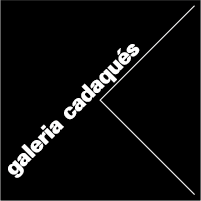
Google as oracular divinity – Technological mysticism or apocalypse? Vertical thinking and pixelated matter – Moving from the image of the real to the virtual image and from the virtual image to a virtual real – The real image and the virtual image to a virtual real – The real image to a virtual real Operating system equals manual system, equals networked system – Technological art is a prosthesis of the art of always with a new knowledge derived from the internautical culture.
“Vertical Thinking and Googlerian Iconography” is an exhibition that presents the work of the artists Paco Chanivet (Seville, 1984) and Carlos González Boy (Puerto Real, Cádiz, 1983), two very new contributions of art derived from technological use and postmodern appropriations. In this way Galeria Cadaqués dos , which has been characterised by presenting the spirit of the new tendencies in art, from concrete art and pop, to conceptual art and early postmodernism, now takes a risk by presenting a change of perception, of manner, of techniques and of support: computer art.
Paco Chavinet fixes the mouse in the manner of an informalist frottagge on a fragment of an image photographed on a surface. If the figures of the real have been assaulted by the pictorial avant-gardes in search of an unprecedented beauty in the non-form, in the Scroll series, the movement is fixed, as in the pioneering futurist photographs. The spectator lives immersed in the river of movement. Viewing time has been accelerated by both thought and virtuality. With these images, the author aims to inaugurate a habitual gaze, irreversibly affected by analogue technology.
At Hiperpoesía 1.0, the poems written by Paco Chavinet have been translated into other languages not through the usual experience of the subjective author-reader-translator but through standard translation systems embedded in the network. Thus, the author intends that what was subjective transferred to objective by the Google translator should be seen by the reader as an altered language experience. Through simultaneous translation programmes, the passage from local to global and back to local cultural space has radically transformed the subject matter and meaning of the communication code.
Carlos González turns to Google as if he were looking for the enigma in the age of the Romantics or the data in the age of the positivists. Google would be the external universe of language, where sources and knowledge are found. Google is also a space with no distinction between text and image. Enter the term “apocalypse” which provides you with a selection of images. The author, uninspired, simply transcribes what is given to him and turns the photographic images into drawn images by means of a black ink tracing. The arbitrary copying system offers the possibility of working with hot and sensitive techniques in a cold operation.
One of the great concerns of art has been to be able to represent in a two-dimensional space that which is three-dimensional and even ethereal. At the crossroads of space and time, the binary issues are resolved, and we finally have a frontal view. Despite the creation of a networked culture that assumes the third and fourth dimensions, Carlos González rethinks the possibility of transferring the real representational world to the virtual one. As if the white wall, the black square of Malevitx, or the minimalist white cube were the first or behind layer of visual reality (in the virtual, Photoshop). In short, it transforms the exhibition space into a graphic interface.
Are these two artists fallen angels or rising pixels, techno-integrated or apocalyptic?
Irene Altaió Carné













